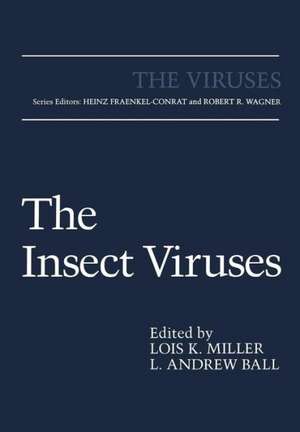The Insect Viruses: The Viruses
Editat de Lois K. Miller, L. Andrew Ballen Limba Engleză Paperback – 28 oct 2012
Din seria The Viruses
- 5%
 Preț: 1420.49 lei
Preț: 1420.49 lei - 5%
 Preț: 1118.94 lei
Preț: 1118.94 lei - 5%
 Preț: 1432.17 lei
Preț: 1432.17 lei - 5%
 Preț: 1434.39 lei
Preț: 1434.39 lei - 18%
 Preț: 960.61 lei
Preț: 960.61 lei - 5%
 Preț: 2136.60 lei
Preț: 2136.60 lei - 5%
 Preț: 379.53 lei
Preț: 379.53 lei - 5%
 Preț: 394.52 lei
Preț: 394.52 lei - 5%
 Preț: 384.08 lei
Preț: 384.08 lei - 15%
 Preț: 653.14 lei
Preț: 653.14 lei - 5%
 Preț: 742.04 lei
Preț: 742.04 lei - 5%
 Preț: 378.24 lei
Preț: 378.24 lei - 5%
 Preț: 381.91 lei
Preț: 381.91 lei - 5%
 Preț: 853.78 lei
Preț: 853.78 lei -
 Preț: 391.61 lei
Preț: 391.61 lei - 5%
 Preț: 724.50 lei
Preț: 724.50 lei - 5%
 Preț: 384.80 lei
Preț: 384.80 lei - 5%
 Preț: 371.66 lei
Preț: 371.66 lei - 5%
 Preț: 383.20 lei
Preț: 383.20 lei -
 Preț: 392.60 lei
Preț: 392.60 lei - 5%
 Preț: 741.51 lei
Preț: 741.51 lei - 5%
 Preț: 391.21 lei
Preț: 391.21 lei - 15%
 Preț: 653.00 lei
Preț: 653.00 lei - 5%
 Preț: 726.15 lei
Preț: 726.15 lei
Preț: 400.26 lei
Nou
Puncte Express: 600
Preț estimativ în valută:
76.59€ • 79.96$ • 63.39£
76.59€ • 79.96$ • 63.39£
Carte tipărită la comandă
Livrare economică 04-18 aprilie
Preluare comenzi: 021 569.72.76
Specificații
ISBN-13: 9781461374374
ISBN-10: 1461374375
Pagini: 444
Ilustrații: XIX, 416 p.
Dimensiuni: 170 x 244 x 23 mm
Greutate: 0.7 kg
Ediția:Softcover reprint of the original 1st ed. 1998
Editura: Springer Us
Colecția Springer
Seria The Viruses
Locul publicării:New York, NY, United States
ISBN-10: 1461374375
Pagini: 444
Ilustrații: XIX, 416 p.
Dimensiuni: 170 x 244 x 23 mm
Greutate: 0.7 kg
Ediția:Softcover reprint of the original 1st ed. 1998
Editura: Springer Us
Colecția Springer
Seria The Viruses
Locul publicării:New York, NY, United States
Public țintă
ResearchCuprins
1 Entomopoxviruses.- I. Introduction.- II. Classification.- III. Virus Structure.- IV. Virus Replication.- V. Entomopoxvirus Genome Structure.- VI. Biological Control.- References.- 2 Invertebrate Iridescent Viruses.- I. Introduction.- II. Classification.- III. Structure and Composition.- IV. Replication and Molecular Biology.- V. Signs and Characteristics of Patent Disease.- VI. Relationships among IVs.- VII. Ecology.- VIII. Use of Iridescent Viruses in Biocontrol.- References.- 3 Nudiviruses.- I. Introduction.- II. Oryctes Virus.- III. Hz-1 Virus.- IV. Gonad-Specific Virus.- V. Other Nudiviruses.- References.- 4 Ascoviruses.- I. Introduction.- II. Structure and Classification.- III. Cytopathology and Assembly.- IV. Histopathology and Disease Presentation.- V. Transmission and Occurrence.- VI. Summary.- References.- 5 Polydnavirus Biology, Genome Structure, and Evolution.- I. Introduction.- II. Polydnavirus and Parasitoid Classification.- III. Polydnavirus Morphology and Genomes.- IV. Polydnavirus Genome Organization.- V. Polydnavirus Replication.- VI. Polydnavirus Gene Expression.- VII. Polydnavirus Evolution.- VIII. Future Directions.- References.- 6 Biological and Molecular Properties of Densoviruses and Their Use in Protein Expression and Biological Control.- I. Introduction.- II. Pathologies Associated with Densoviruses.- III. Host Range.- IV. Replication of Densoviruses in Insect Cell Cultures.- V. Composition and Structure of Densoviruses.- VI. Molecular Biology of Densoviruses.- VII. Development of DNV-Derived Expression Vectors.- VIII. Use of DNVs for Biological Control of Insect Pests.- References.- 7 Structural Studies of Nodaviruses and Tetraviruses.- I. Introduction.- II. Nodavirus Particle.- III. Particle Maturation.- IV. Protein—RNA InteractionsDerived from Cryo-Electron Microscopy and X-Ray Analysis.- V. Viral Entry and RNA Delivery.- VI. Tetravirus Structure and Function.- VII. Conclusions.- References.- 8 Nodaviruses of Insects.- I. Introduction.- II. Classification and Taxonomy.- III. Isolation, Ecology, and Natural Infections.- IV. Host Cell Interactions and Cytopathology.- V. Virion Composition, Properties, and Structure.- VI. Genome Organization and Molecular Biology.- VII. Virus Replication Cycle.- VIII. Viral Genetics.- IX. Experimental RNA Replication Systems.- X. Technological Applications of the Nodaviridae.- XI. Conclusions and Summary.- References.- 9 Tetraviruses.- I. Introduction and History.- II. Taxonomy, Serology, and Host Range.- III. Purification.- IV. Virion Properties and Structure.- V. Genome Organization and Molecular Biology.- VI. Pathobiology.- VII. Epidemiology and Ecology.- VIII. Tetraviruses and Biotechnology.- IX. Concluding Remarks.- References.- 10 Picornalike Viruses of Insects.- I. Introduction.- II. The Picornalike Viruses.- III. The Cricket Paralysis Virus-Drosophila C Virus Complex.- IV. The Picornalike Viruses of Domesticated Bees.- V. The Picornalike Viruses of Dipterans.- VI. The Picornalike Viruses of Hemipterans.- VII. The Picornalike Viruses of Lepidopterans.- VIII. Summary.- References.- 11 Cypoviruses.- I. Introduction.- II. Biochemical Characteristics of the Cypoviruses.- III. Classification and Strain Characteristics.- IV. Viral Replication Cycle.- V. Effects of the Virus Infection.- VI. Interactions of CPV with Insect Pathogens: Synergisms and Antagonisms.- VII. Use of Cypoviruses in Biological Control Programs of Insect Pests.- VIII. Conclusion.- References.- 12 Sindbis Virus Expression Systems for the Manipulation of Insect Vectors.- I. Introduction.- II. Virus Expression Systems.- III. Virogenesis of Alphaviruses in Vectors.- IV. Alphavirus Expression Systems.- V. Sindbis Virus Expression Systems.- VI. Expression of Heterologous Proteins from SIN Virus Transducing System.- VII. Knockout of Bunyaviruses in Mosquitoes Using SIN Expression Systems.- VIII. Knockout of DEN-2 Virus in Mosquitoes Using SIN Expression Systems.- IX. Summary.- References.
Recenzii
`... represents an excellent, comprehensive reference that occupies a previously unfilled niche in the insect pathology literature. It is a great resource for all researchers who study insect viruses. It is also an extremely valuable source of informatio n for those investigators interested in the use of insect viruses for biological control of insect pests.'
BioScience, 50:4 (2000)
`The Insect Viruses belongs on the shelves of insect pathologists, especially insect virologists, right next to The Baculoviruses. This book will also be useful to researchers in other fields who will appreciate the diversity and utility of these viruses: virologists and students of virology, particularly those interested in virus evolution or structure, entomologists interested in biological control of insects, insect immunity or diseases carried by insect vectors, and biotechnologists immediately spring to mind.'
Trends in Microbiology, 7:11 (1999)
BioScience, 50:4 (2000)
`The Insect Viruses belongs on the shelves of insect pathologists, especially insect virologists, right next to The Baculoviruses. This book will also be useful to researchers in other fields who will appreciate the diversity and utility of these viruses: virologists and students of virology, particularly those interested in virus evolution or structure, entomologists interested in biological control of insects, insect immunity or diseases carried by insect vectors, and biotechnologists immediately spring to mind.'
Trends in Microbiology, 7:11 (1999)












